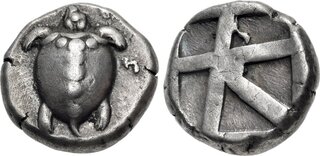| Classical Numismatic Group > Triton XXVII | Auction date: 9 January 2024 |
| Lot number: 188 Price realized: 3,875 USD (Approx. 3,549 EUR) Note: Prices do not include buyer's fees. | Show similar lots on CoinArchives Find similar lots in upcoming auctions on |
| Lot description: ISLANDS off ATTICA, Aegina. Circa 480-457 BC. AR Stater (20.5mm, 12.24 g, 1h). Sea turtle, head in profile, with 'T-back' design on shell / Large square incuse with skew pattern. Meadows, Aegina, Group IIIa; Milbank Period III, pl. I, 15; HGC 6, 435; SNG Copenhagen 507; SNG Delepierre 1522–6; ACGC 123; Boston MFA 1111–2; Dewing 1674–8; Gillet 947; Gulbenkian 523; Jameson 1199; Rosen 219. Toned, light granularity, minor obverse die break in right field, light graffito on reverse. Good VF. The first coins produced on the island of Aegina depicted a sea turtle (emblematic of the marine interests of the Aeginetans) on the obverse, while bearing on the reverse the imprint of the punch used to force metal into the obverse die. The reverse punch originally consisted of an eight-pronged design that produced eight triangles; with use the prongs broke and clogged, producing filled and absent incuses. This led to the adoption first of a "mill sail" pattern, followed by the development of a "skew" pattern. The obverse design was also modified by the addition of a row of dots added at the collar from the earlier collared turtle design with a single row of dots down its shell, hence the name "T-back," circa 480 BC (the present example). The production of turtles decreased over the next twenty years as silver from the island of Siphnos was no longer available and Mediterranean trade was now dominated by Athens, the new mistress of the Aegean. In 457 BC, Athens conquered Aegina and stripped her of her maritime powers. Following the loss of her naval autonomy, Aegina produced staters with a land tortoise on the obverse in lieu of her former emblematic sea turtle. Estimate: 3000 USD |  |



